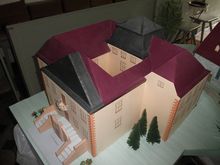Griesheim Castle
Coordinates: 50 ° 45 ′ 9.6 " N , 11 ° 2 ′ 22.5" E
The Griesheim castle was a baroque structure that around 1735 in Griesheim in Thuringia , modernized built in the 1920's and 1948 based on the infamous command 209 of the Soviet Military Administration was demolished.
history
From the 12th century to 1717 the Lords of Griesheim lived on estates in Griesheim with the associated "Edelhof" . In 1720 Christian August von Lindenfels acquired the upper court and in 1739 also the lower court of the manor . During this time the two-storey baroque castle on the Kirchberg was built, including the remains of the old manor house. From then on, the castle and church defined the image of Griesheim for centuries. In 1744 the goods were sold to the Princely Chamber of Rudolstadt and acquired by Carl Joseph von Hoheneck in 1751 . After three generations in the possession of this family, the property was sold again to the Princely Chamber of Rudolstadt in 1834. This leased the goods to "noble" tenants and officials. Since a new administrator's house was built in 1851, the castle was uninhabited for decades. However, it was inspected twice a year and deficiencies were corrected. In 1898 the beautiful but dilapidated arbor was removed. The old corridor from the upper floor of the palace to the neighboring church of Maria Magdalena has also been removed.
From 1909 Gerhard Jordan became one of two tenants of the Princely Chamber Estate. He returned from WWI as a major. Griesheim became the state domain of the new state of Thuringia . From 1924 Jordan was the sole tenant. He had successfully applied for the "rehabilitation" of the castle, which also took place in 1922–1924 - with the participation of Jordan. The modernization included the construction of a flight of stairs and a balcony, as well as hot water heating for the whole house.
The two-storey castle was an 18-meter-high, 30 (37) by 25-meter almost square building with an atrium in the middle. The building had a complete basement with cross vaults. In addition to a ballroom, it comprised 16 other rooms. Most of them had stucco ceilings, and there were artistically valuable old ovens on both floors. The castle was in good structural condition until the end of the war in 1945.
From 1944 the nuclear physicist Dr. Kurt Diebner with his family and some employees in the castle. He conducted research in an experimental laboratory in Stadtilm because he had to leave the research facility in Gottow near Berlin. Shortly after the Wehrmacht had evacuated thieves to Bavaria, a scientific search party ("Alsos") appeared in the castle with the US occupation . He immediately asked for the physicist and examined the lock thoroughly. Frustrated by the lack of secrets, the Americans feasted on the red wine they found. This is what Major Jordan's daughter described, who was caring for her sick father. The last tenant of the castle and estate died in 1945. Refugees from the east moved into the castle.
Under Soviet occupation, the expropriated 150 hectares of land from the domain, buildings, cattle, machines and equipment were divided up among 37 families by a local land reform commission.
At the beginning of 1948, on the basis of order 209 of the SMAD , the state and district commission for the implementation of the land reform ordered "the demolition of the castle for material extraction for new farms". The local chronicle noted: In Griesheim there were initially difficulties with the beginning of the demolition. Many residents, including the local priest, were against demolition because the building was in good condition and because four families with 20 people ("resettlers") were housed in it. Finally, in April, the roof was covered. A short time later, courageous citizens covered the roof again. But under pressure from the Soviets and under threat of punitive measures, the demolition was carried out in a very short time by a foreign special command in late summer. Only a mound of earth today reminds of the location of the Griesheim Castle. The gain in suitable building material (sandstone, cast iron supports) for the foundations and cellars of 9 new farms was very low. Employees of the Arnstadt Castle Museum were able to save three valuable baroque ovens, various cupboards and the lion figures on the outside staircase. Monument preservers had spoken out against the demolition.
The state of Thuringia has its own castle demolished. It was under considerable Soviet pressure. In a letter to the Prime Minister of Thuringia, the head of SMAD Thuringia, Major General Kolesnitschenko, raised serious allegations against the places that were supposed to be tearing down mansions and castles: sabotage, undermining Command 209, hostile propaganda, "criminal slowness" in the case of demolitions, harmful practice of "snatching up" such buildings for public and cultural purposes in order to save them. That could be done with.
literature
- Hans-Helmut Lawatsch: Griesheimer century outline . In: Contributions to home history, City and District of Arnstadt, Issue 9, Arnstadt 1990, pp. 75–79
- Hans-Helmut Lawatsch: Physical explosiveness from a political shell: Kurt Diebner. In: Contributions to local history, City and District of Arnstadt, Issue 9, Arnstadt 1990, pp. 91–98
- Notes from the local chronicler of Griesheim, Gerhard Fuchs
- Thomas Bienert: Abused. Disappeared castles (12): The baroque palace in Griesheim near Stadtilm. Thuringian General, 2006
Individual evidence
- ^ Letter from the administration of SMAD Thuringia in Weimar to the Prime Minister of Thuringia, dated April 21, 1948


